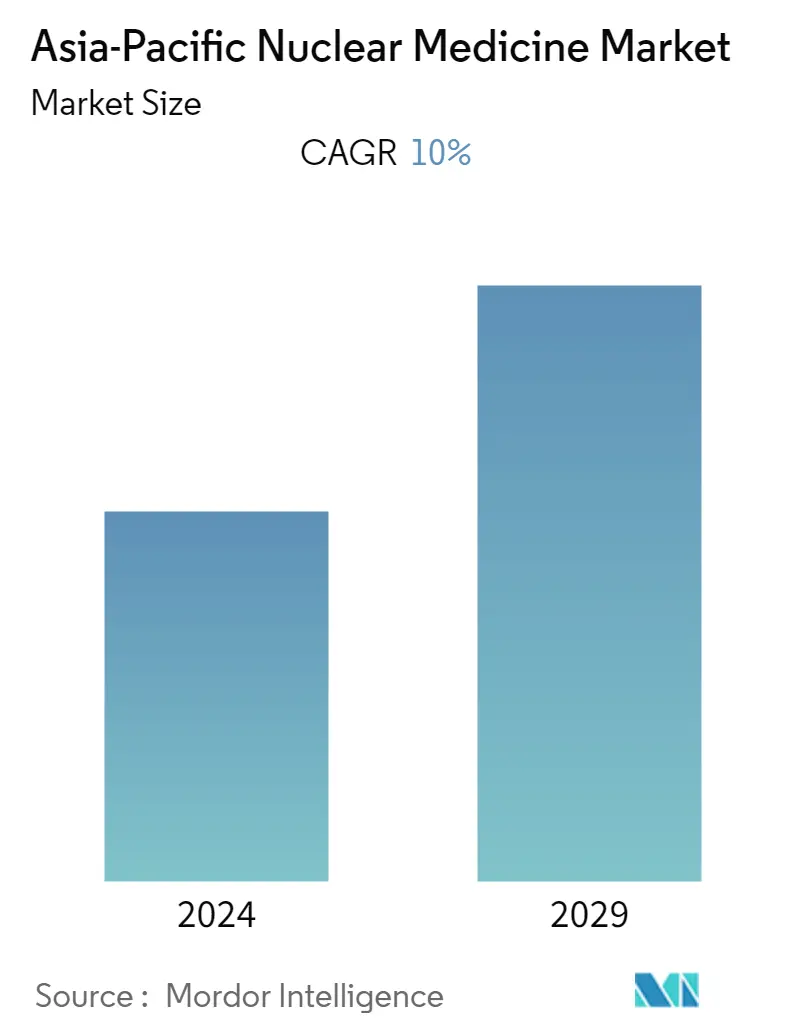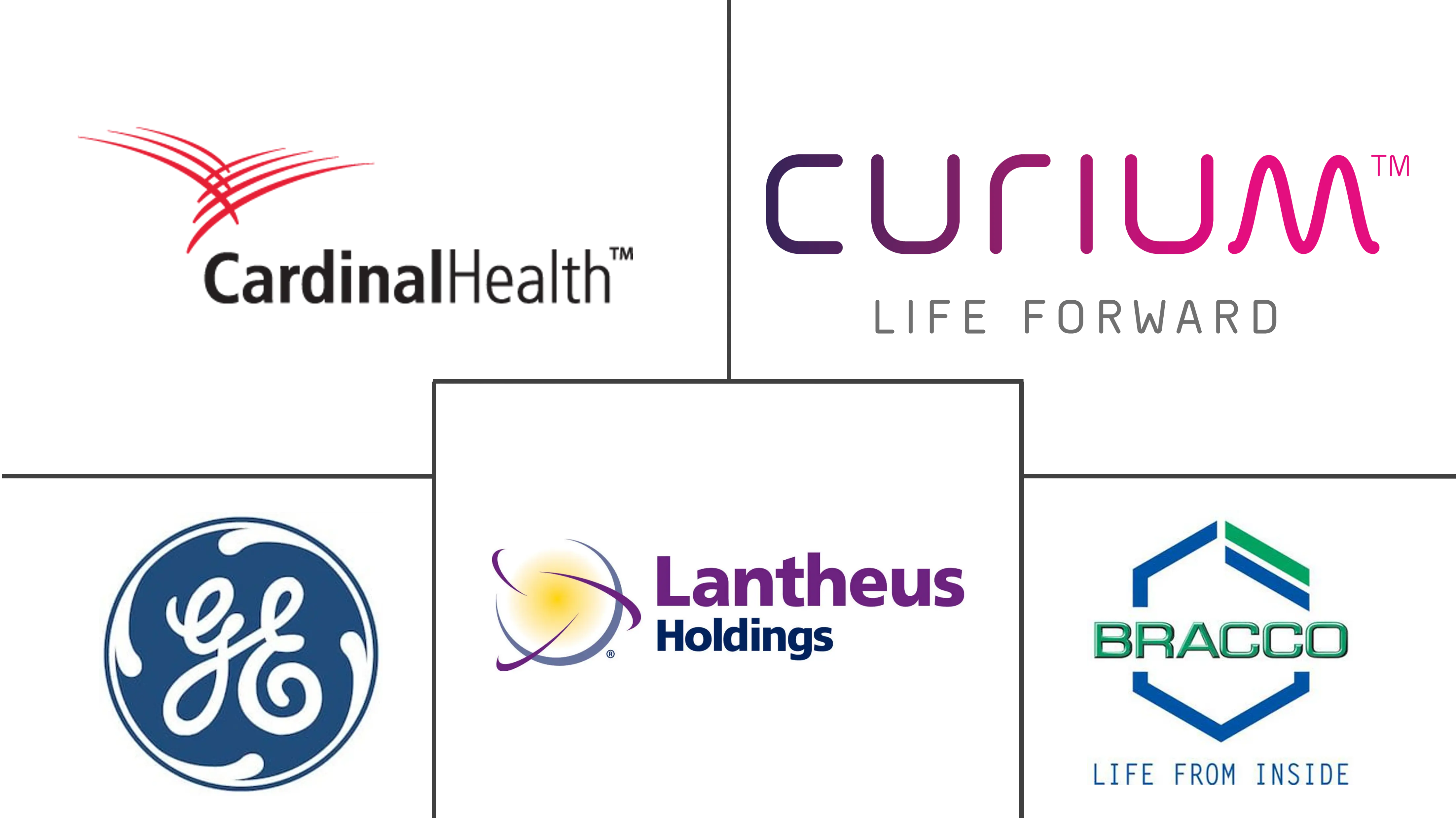Market Size of Asia-Pacific Nuclear Medicine Industry

| Study Period | 2019 - 2029 |
| Base Year For Estimation | 2023 |
| Forecast Data Period | 2024 - 2029 |
| Historical Data Period | 2019 - 2022 |
| CAGR | 10.00 % |
Major Players
*Disclaimer: Major Players sorted in no particular order |
Need a report that reflects how COVID-19 has impacted this market and its growth?
APAC Nuclear Medicine Market Analysis
The Asia-Pacific Nuclear Medicine Market is expected to register a CAGR of 10.0% during the forecast period.
The COVID-19 pandemic has posed severe challenges to healthcare systems in Asia-Pacific. It has primarily been controlled by drastically cutting down in- and outpatient services for diseases and implementing infection prevention and control measures. For instance, an article published in January 2022 stated that the practice of nuclear medicine was reduced significantly as Asian countries were affected by the COVID-19 pandemic. In addition, as per the same source, some of the factors that resulted in the closure of a quarter of nuclear medicine clinics in the region were the lack of radioactive isotopes supplies, conversion of nuclear medicine wards into COVID-19 wards, and the deployment of doctors and paramedics to assist in the management of COVID-19 cases. Also, it has been observed that the supply of radioactive isotopes was severely reduced by 50% and was absent in 25% of these departments. Furthermore, from the same source, a survey conducted from March to April 2021 showed that the practice and supply of nuclear medicine and radioactive isotopes have recovered, and the rule of nuclear medicine increased by 41% in 2021. Thus, COVID-19 has significantly impacted market growth.
Specific factors propelling the market growth are the rising prevalence of cancer and cardiac disorders and the increasing demand for biosimilar drugs due to their cost-effectiveness.
The increasing number of chronic disease cases, such as cardiac disorders and cancer, is the key factor driving the market growth. For instance, from a study published in May 2022, it has been observed that 805 persons with type 2 diabetes (T2D) were enrolled in China, 273 of whom had established cardiovascular disease (CVD), with an estimated prevalence (95%) of 33.9% and most CVD cases were atherosclerotic (94.9%). As per the same source, coronary heart disease had the highest estimated prevalence (16.0%), followed by carotid artery disease (9.6%) and cerebrovascular disease (7.7%). Thus, the rising burden of cardiovascular disease among the population is expected to increase the demand for nuclear medicine for diagnosing, assessing, and evaluating coronary artery diseases and cardiomyopathy, as well as identifying possible damage to the heart from chemotherapy or radiotherapy, propelling the market growth.
Additionally, according to the Globocan 2020 report, over 19,617 new breast cancer cases were reported in Australia in 2020. This number is projected to increase by 33.2% to around 26,130 new breast cancer cases by 2040. Thus, the rising burden of cancer among the population is expected to increase the demand for nuclear medicine that helps physicians detect tumors and their spread in the area, as well as the radioactive molecules (drugs) that help to kill the cancer cells in the body, thereby fueling the market growth.
Similarly, self-reported data from the Australian Bureau of Statistics 2020-21 National Health Survey showed that 571,000 Australians aged 18 and over (2.9% of the adult population) had chronic heart disease. Thus, the high burden of chronic illness is expected to increase the demand for nuclear medicine that helps diagnose and assess heart diseases and identify possible damage to the heart from chemotherapy or radiotherapy, thereby propelling the market growth.
Furthermore, from a study published in May 2021, it has been observed that the overall crude prevalence of Parkinson's disease in India was around 42.3 per 100,000, and the majority over the age of 60 was 308.9 per 100,000, which showed a trend of increasing disease prevalence with age. Also, as per a population-based cross-sectional survey published in February 2022, in China, the standardized prevalence of Parkinson's disease in urban areas (1.98%) was higher than that in rural regions (1.48%), and the crude prevalence of PD in men (2.12%) was higher than that in women (1.66%). Hence, the increasing burden of Parkinson's disorder is expected to increase the demand for PET scans to assess the activity and function of brain regions involved in the movement, which is anticipated to augment the market growth over the forecast period.
However, the high cost of diagnostic and therapeutic equipment and procedures and regulatory uncertainty hinder the market growth over the forecast period.
